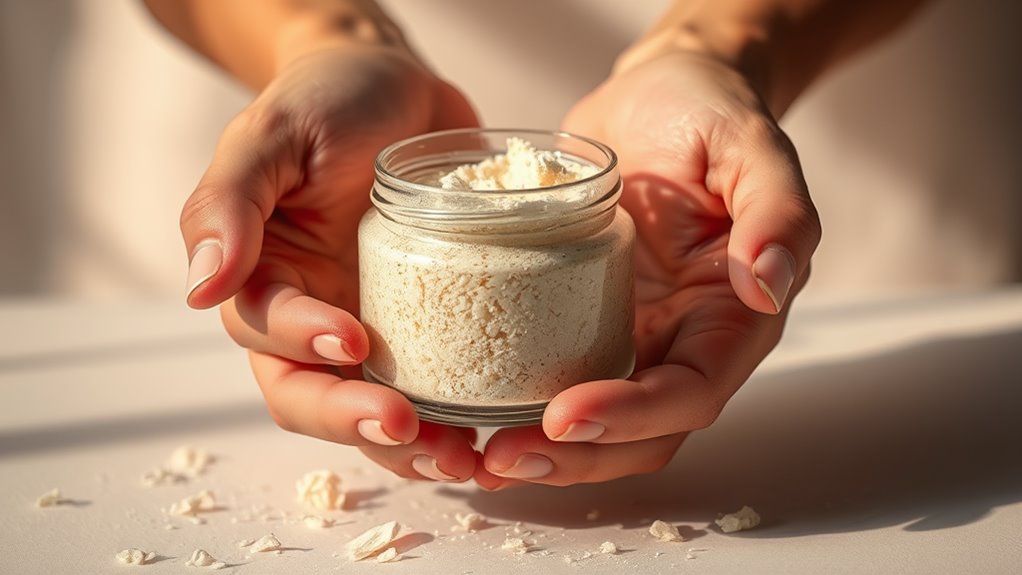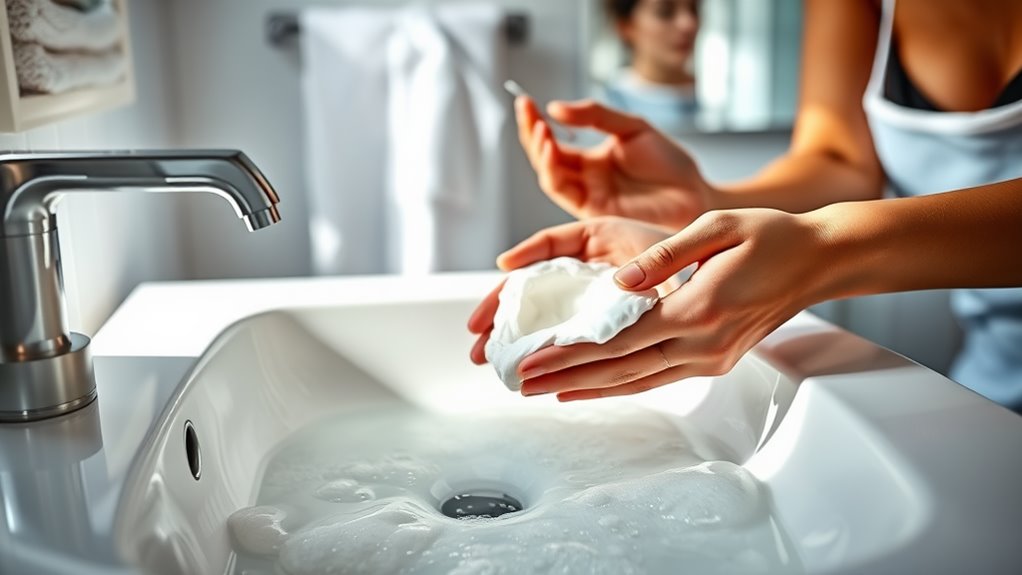How to Build a Skincare Routine That Actually Suits Your Skin
To build a skincare routine that suits your skin, start by identifying your skin type—oily, dry, combination, or sensitive—and specific concerns like acne or aging. Choose products that align with your skin’s needs, including the right cleanser, exfoliant, and moisturizer. Always patch test new products and incorporate sunscreen to protect against UV damage. Monitor your skin’s response to products, adjust as necessary, and consult a dermatologist for persistent issues; this approach can enhance your skincare journey significantly.
Key Takeaways
- Identify your skin type (oily, dry, combination, or sensitive) to tailor your routine effectively.
- Choose appropriate cleansers, toners, serums, and moisturizers that align with your skin type and concerns.
- Incorporate exfoliation 1-3 times a week to promote cell turnover and improve product absorption.
- Always apply broad-spectrum sunscreen with at least SPF 30 daily, regardless of weather conditions.
- Monitor your skin’s response to products and adjust your routine seasonally or as needed for optimal results.
Understanding Your Skin Type
Before you can effectively build a skincare routine, it’s essential to understand your skin type, as this knowledge forms the foundation for selecting suitable products.
Your skin can generally be categorized as oily, dry, combination, or sensitive. Each type has specific characteristics and requires tailored ingredients to maintain balance and health.
For instance, if you have oily skin, lightweight, oil-free products are ideal, whereas dry skin benefits from richer, hydrating formulations.
Identifying your skin type allows you to create a personal skincare routine that addresses its unique needs, enhancing efficacy.
Utilizing diagnostic methods, such as observing skin behavior after cleansing, can provide insights into your type.
Ultimately, accurate identification empowers you to optimize your skincare strategy effectively. Additionally, understanding your skin type can guide you in choosing suitable products that will improve your overall skin health.
Identifying Your Skin Concerns
How can you pinpoint your specific skin concerns? Start by observing your skin’s behavior over time. Identify issues like dryness, oiliness, acne, or sensitivity.
Keep a journal to track changes related to diet, stress, and environmental factors. This will help you notice patterns and triggers. You can also consult a dermatologist for professional insights; they can conduct assessments and recommend treatments based on clinical evidence.
Additionally, utilize skin analysis tools or apps that evaluate texture, pigmentation, and elasticity. Understanding your skin’s unique needs is crucial for effective product selection. Furthermore, consider the impact of persistent breakouts that may arise despite your routine, as they can indicate underlying issues that need to be addressed.
The Importance of Patch Testing
Patch testing is crucial for preventing allergic reactions and ensuring product compatibility with your skin.
By applying a small amount of a new product to a discreet area, you can assess how your skin reacts before committing to full application. This simple step can save you from potential irritation and help you build a more effective skincare routine. Additionally, it allows you to understand your skin’s unique needs and choose products that truly benefit your complexion.
Preventing Allergic Reactions
When introducing new skincare products, it’s crucial to prioritize safety by conducting a patch test, as this simple step can help prevent allergic reactions that may lead to irritation or more severe skin issues.
A patch test involves applying a small amount of the product to a discreet area of skin, typically on your forearm, and observing for any adverse reactions over 24 to 48 hours.
Research shows that many skincare formulations contain potential allergens, such as fragrances or preservatives, which can provoke sensitivities.
By taking this precaution, you can identify problematic ingredients before incorporating them into your routine, ultimately safeguarding your skin’s health.
Prioritize patch testing to refine your regimen and ensure that your products align with your unique skin chemistry.
Ensuring Product Compatibility
Understanding the compatibility of skincare products is essential for maintaining healthy skin, especially since combining certain ingredients can lead to irritation or diminished effectiveness.
To ensure your products work harmoniously, consider these key points:
-
Patch Test New Products: Apply a small amount on your forearm to check for any adverse reactions before full application.
-
Research Ingredients: Familiarize yourself with potentially conflicting components, such as retinoids and vitamin C, which can cause irritation when used together.
-
Monitor Skin Reactions: Keep a journal documenting any changes or reactions when introducing new products to identify what works best for you.
Choosing the Right Cleanser
When choosing the right cleanser, it’s essential to consider your skin type, as different formulations cater to varying needs. Understanding ingredient awareness will help you avoid potential irritants and select products that enhance your skin’s health. Additionally, employing proper application techniques can maximize the effectiveness of your cleanser, ensuring a thorough and gentle cleanse. For instance, those with oily skin may benefit from gel-based cleansers that help control excess oil.
Skin Type Considerations
Choosing the right cleanser is crucial for maintaining healthy skin, as it sets the foundation for your entire skincare routine.
Different skin types require specific formulations to effectively address their unique needs.
Consider the following when selecting your cleanser:
-
Oily Skin: Look for gel-based cleansers with salicylic acid to control excess oil and prevent breakouts.
-
Dry Skin: Opt for cream or oil-based cleansers that hydrate while removing impurities without stripping natural oils.
-
Combination Skin: Choose a gentle foaming cleanser that balances both oily and dry areas, ensuring thorough yet mild cleansing.
Ingredient Awareness
Ingredient awareness is essential for selecting the right cleanser, as the components can significantly impact your skin’s health and function. Understanding the ingredients helps you avoid harmful effects and enhances your skincare routine. Here’s a brief overview of common cleanser ingredients:
| Ingredient | Benefit | Skin Types |
|---|---|---|
| Salicylic Acid | Exfoliates, combats acne | Oily, Acne-prone |
| Glycerin | Hydrates, maintains moisture | Dry, Normal |
| Tea Tree Oil | Antimicrobial, reduces inflammation | Oily, Acne-prone |
Application Techniques
Selecting an appropriate application technique for your cleanser can make a significant difference in your skincare results.
The way you apply your cleanser influences its effectiveness and your skin’s overall health. Consider these techniques to enhance your routine:
-
Gentle massaging: Use your fingertips in a circular motion to stimulate circulation and promote absorption.
-
Warm water rinse: Begin with warm water to open pores, allowing the cleanser to penetrate deeper and remove impurities more effectively.
-
Proper timing: Allow the cleanser to sit on your skin for a minute before rinsing; this maximizes its benefits.
Incorporating Exfoliation
While many people understand the importance of cleansing and moisturizing in their skincare routines, incorporating exfoliation can significantly enhance your skin’s texture and appearance.
Exfoliation removes dead skin cells, promoting cell turnover and revealing a fresher complexion. Regular exfoliation can improve the efficacy of your other products, allowing serums and moisturizers to penetrate more effectively. The vital role of exfoliation is often underestimated, yet it plays a crucial part in preventing rough and uneven skin texture.
Depending on your skin type, consider using either physical exfoliants, like scrubs, or chemical exfoliants, such as AHAs and BHAs. Start with gentle formulations to avoid irritation, especially if you’re new to exfoliation.
Aim to exfoliate 1-3 times a week, adjusting frequency based on your skin’s response. By mastering this step, you contribute to a radiant, healthy-looking complexion that reflects your commitment to skincare excellence.
Selecting the Perfect Toner
After establishing a solid exfoliation routine, the next step in refining your skincare regimen involves choosing a toner that aligns with your skin’s needs.
A well-selected toner can help balance your skin’s pH, minimize pores, and enhance absorption of subsequent products.
Here are some considerations when selecting your toner:
-
Ingredients: Look for hydrating elements like glycerin or hyaluronic acid, or soothing agents like chamomile or aloe.
-
Skin Type: Opt for alcohol-free formulas if you have dry or sensitive skin, while those with oily skin may benefit from toners with salicylic acid.
-
Purpose: Identify what you want to achieve—hydration, exfoliation, or oil control.
Finding a Suitable Serum
How can you elevate your skincare routine further? A well-chosen serum can target specific concerns like fine lines, hyperpigmentation, or acne.
Begin by identifying your primary skin issue; for instance, if you seek hydration, look for serums containing hyaluronic acid. If you’re combating aging, consider those with retinol or peptides, which have been shown to stimulate collagen production.
It’s crucial to assess your skin type—oily, dry, or combination—when selecting a serum, as this influences ingredient efficacy. Always patch-test new products to prevent adverse reactions.
Additionally, incorporate serums with antioxidants, such as vitamin C, to enhance your skin’s protection against environmental stressors. By meticulously selecting your serum, you can significantly enhance your skin’s overall health and appearance.
Choosing Moisturizers for Your Skin
When selecting a moisturizer, understanding your skin type is crucial, as it influences how your skin absorbs and responds to different formulations.
Pay attention to key ingredients that align with your specific needs, such as hyaluronic acid for hydration or ceramides for barrier support.
Additionally, the techniques you use during application can enhance product efficacy, ensuring your skin receives maximum benefits.
Skin Type Importance
Understanding your skin type is crucial for selecting the right moisturizer. Different skin types have unique needs that affect how products perform on your skin. Here are three key factors to consider:
-
Oily Skin: Look for lightweight, oil-free moisturizers to avoid clogging pores.
-
Dry Skin: Choose richer, hydrating formulas that provide deep moisture and barrier repair.
-
Combination Skin: Opt for balanced moisturizers that hydrate dry areas without overwhelming oilier zones.
Identifying your skin type allows you to target specific concerns effectively.
Using the right moisturizer can enhance your skin’s overall appearance and health.
Ingredients to Consider
Selecting the right moisturizer involves more than just knowing your skin type; it requires an awareness of the ingredients that will benefit your skin most.
Look for humectants like hyaluronic acid and glycerin, which draw moisture into the skin. If you have dry skin, opt for occlusives such as shea butter or squalane, which lock in hydration.
For oily or acne-prone skin, lightweight emollients like jojoba oil can provide balance without clogging pores. Additionally, incorporating ingredients like niacinamide can enhance skin barrier function and reduce inflammation.
Always check for potential irritants, especially if you have sensitive skin. By selecting targeted ingredients, you can optimize hydration and promote overall skin health effectively.
Application Techniques Matter
While the right moisturizer can significantly impact your skin’s health, how you apply it’s equally important. Proper application techniques ensure that your skin absorbs the beneficial ingredients effectively.
Here are three strategies to enhance your moisturizing routine:
-
Clean Hands: Always start with clean hands to prevent introducing bacteria to your skin.
-
Pat, Don’t Rub: Gently pat the moisturizer onto your skin, allowing it to absorb rather than rubbing it in, which can irritate sensitive areas.
-
Layering: Apply your moisturizer while your skin is still slightly damp, as this helps lock in hydration more effectively.
The Role of Sunscreen in Your Routine
Sunscreen serves as a crucial barrier against harmful ultraviolet (UV) rays, which can lead to skin damage and accelerate aging.
By incorporating a broad-spectrum sunscreen with at least SPF 30 into your daily skincare routine, you significantly reduce the risk of skin cancers and photoaging.
UVA rays penetrate deeper, contributing to wrinkles and loss of elasticity, while UVB rays cause sunburns. Regular application—ideally every two hours—ensures consistent protection.
Remember to apply it even on cloudy days, as up to 80% of UV rays can still reach your skin.
Choosing a formulation that suits your skin type—whether it’s oily, dry, or sensitive—can enhance both efficacy and comfort.
Prioritizing sunscreen is non-negotiable for achieving and maintaining healthy skin.
Adjusting Your Routine for Seasonal Changes
As the seasons change, your skincare routine should adapt to varying environmental factors that impact your skin’s health.
Each season brings unique challenges and requires specific adjustments to maintain optimal skin condition.
Consider the following when tailoring your routine:
- Hydration: In winter, switch to a heavier moisturizer to combat dryness.
During summer, opt for lightweight formulations to avoid excess oil.
- Exfoliation: Increase exfoliation in spring to remove dull skin after winter;
decrease it in fall and winter to prevent irritation.
- Sunscreen: Use broad-spectrum sunscreen year-round,
but increase the SPF in summer for stronger UV protection.
Monitoring Your Skin’s Response
To ensure your skincare routine is effective, it’s crucial to monitor how your skin responds to different products and environmental changes. Start by keeping a skincare journal, noting any new products, your skin’s condition, and any reactions.
Look for signs such as redness, dryness, or breakouts, which indicate incompatibility. Additionally, consider external factors like humidity and UV exposure, as these can alter your skin’s needs.
Analyze patterns over time; for instance, if certain ingredients consistently cause irritation, it’s wise to eliminate them. Adjust your routine based on these observations, ensuring it evolves with your skin’s unique requirements.
Mastering this monitoring process empowers you to achieve optimal skin health, promoting a tailored regimen that enhances your natural beauty.
When to Seek Professional Advice
Recognizing when to seek professional advice is a key component of maintaining skin health. While self-assessment is valuable, certain signs indicate that it’s time to consult a dermatologist. Ignoring these can lead to worsening conditions.
- Persistent acne or breakouts that don’t respond to over-the-counter treatments
- Unexplained skin changes, such as new moles or discoloration
- Severe dryness, redness, or irritation that interferes with daily life
Addressing these issues with a professional can provide targeted solutions and prevent long-term damage.
Dermatologists can offer personalized insights based on your skin type and concerns, ensuring that your skincare routine is effective and safe.
Don’t hesitate to prioritize your skin’s health; seeking help early can lead to better outcomes.




